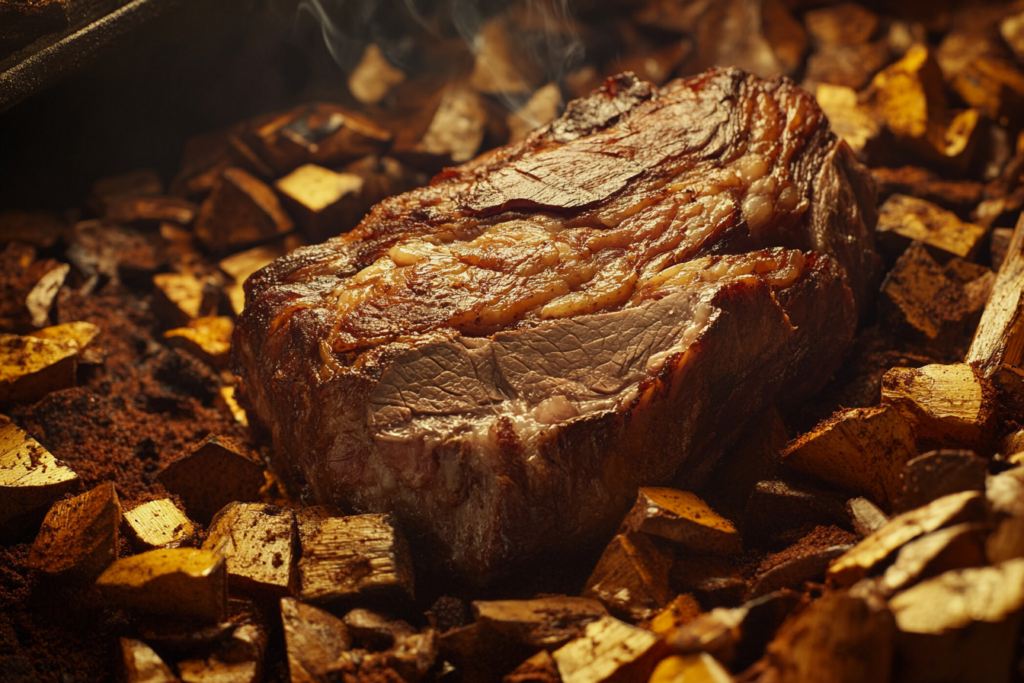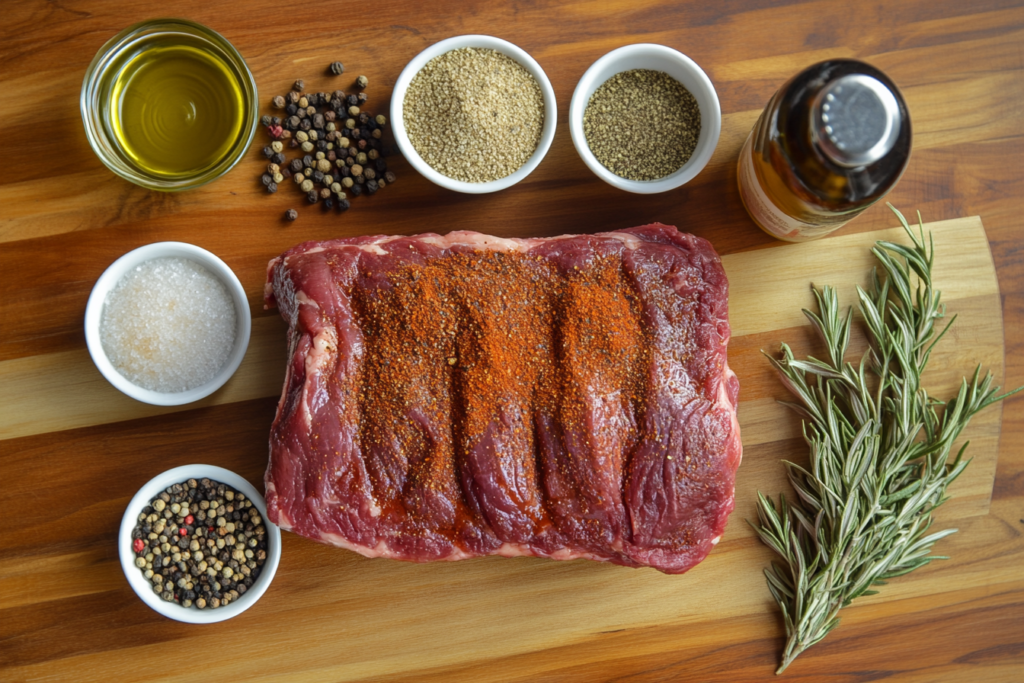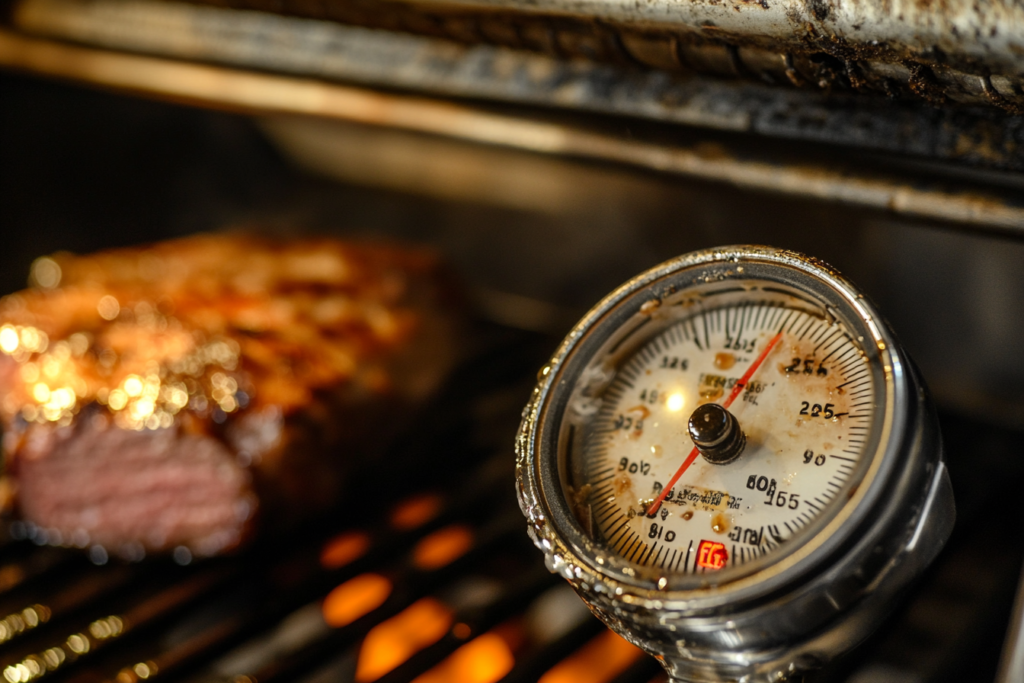Introduction
Smoking meat has become one of the most beloved methods of preparing delicious, tender, and flavorful meals. Among the various cuts of beef available, chuck roasts are gaining popularity in the smoking community. But are chuck roasts good for smoking? The short answer is: absolutely! With the right techniques, seasonings, and smoker setup, a chuck roast can transform into a juicy, smoky masterpiece.
In this article, we’ll explore what makes a chuck roast an excellent candidate for smoking. From its natural marbling to its cost-effectiveness, you’ll discover why this humble cut of meat deserves a spot in your smoker. Whether you’re a barbecue novice or a seasoned pitmaster, read on to uncover the secrets to perfectly smoked chuck roast.
What is a Chuck Roast?
Characteristics of Chuck Roast
Chuck roast is a cut of beef taken from the shoulder region of the cow. Known for its rich flavor and marbling, it’s a popular choice for braising, slow-cooking, and smoking. But are chuck roasts good for smoking overall? Absolutely! The shoulder muscles are well-used, which makes the meat tougher than premium cuts like ribeye or tenderloin. However, this toughness comes with a silver lining: abundant connective tissue and fat. When cooked low and slow, the collagen breaks down, yielding tender, juicy meat.
Key characteristics of chuck roast include:
- Well-Marbled Texture: The intramuscular fat melts during cooking, enhancing flavor and tenderness.
- Affordable Pricing: Compared to other beef cuts like brisket, chuck roast is more budget-friendly.
- Versatile Cut: Besides smoking, chuck roast is ideal for pot roasts, shredded beef, and stews.
Popular Uses of Chuck Roast
While smoking is becoming a top choice, chuck roast has been a classic in kitchens worldwide for decades. Its adaptability makes it suitable for various cuisines and cooking methods, such as:
- Pot Roast: Slow-cooked with vegetables for a comforting family meal.
- Pulled Beef: Shredded for tacos, sandwiches, or sliders.
- Grilled Steaks: When sliced into smaller portions, chuck roast can be grilled like steak.
- Beef Stew: Simmered in broth for hearty soups or stews.
The ability to transform this cut into so many dishes demonstrates its culinary versatility. But when smoked, chuck roast truly shines, combining its bold beefy flavor with the aromatic notes of wood smoke.
Why Smoke a Chuck Roast?

Flavor and Tenderness Benefits
Smoking a chuck roast is an excellent way to amplify its natural flavors. But are chuck roasts good for smoking overall? Absolutely! The slow-cooking process at low temperatures allows the connective tissue and fat to break down while infusing the meat with a deep, smoky flavor. When cooked correctly, the exterior develops a caramelized crust, known as the bark, while the interior becomes tender and juicy.
Key benefits of smoking a chuck roast include:
- Rich Smoky Flavor: The prolonged exposure to wood smoke creates layers of complex flavors.
- Melt-in-Your-Mouth Texture: As collagen converts to gelatin, the meat becomes fork-tender.
- Moisture Retention: The gradual cooking process locks in the juices.
Cost-Effectiveness
Compared to brisket, another popular smoked cut, chuck roast is much more affordable. While brisket can cost upwards of $8–$12 per pound, chuck roast often runs between $4–$7 per pound. This makes it an ideal choice for those experimenting with smoking techniques without breaking the bank.
Accessibility
Chuck roasts are readily available in most grocery stores and butcher shops. Unlike specialized cuts that might require pre-ordering, you can usually find chuck roast fresh or frozen, making it a convenient option for last-minute barbecue plans.
How to Smoke a Chuck Roast
Smoking a chuck roast requires a blend of preparation, patience, and technique. Are chuck roasts good for smoking compared to pricier cuts like brisket? With the right approach, the answer is a resounding yes! This affordable cut of meat can rival the tenderness and flavor of more expensive options. Here’s a step-by-step guide to smoking a chuck roast.
Choose the Right Wood for Smoking
The type of wood you use for smoking plays a significant role in the final flavor of your chuck roast. Different woods impart different levels of smokiness and subtle flavors:
- Hickory: A strong, classic smoke flavor that pairs well with beef.
- Oak: Balanced and not overpowering, oak is perfect for longer smokes.
- Mesquite: Bold and intense, but use sparingly as it can overwhelm.
- Fruit Woods (Apple, Cherry, or Pecan): Lighter, slightly sweet, and good for enhancing the natural flavor of the beef.
Prepare the Chuck Roast
Proper preparation is essential for ensuring the meat absorbs smoke and remains moist throughout the cooking process.

- Trim Excess Fat: While the marbling is desirable, large chunks of fat on the exterior may hinder seasoning adhesion and create flare-ups in the smoker.
- Season Generously: Use a dry rub to enhance the flavor of the beef. Common spices include:
- Salt
- Black pepper
- Paprika
- Garlic powder
- Onion powder
- Cayenne (optional for a spicy kick)
Set Up Your Smoker
To achieve the best results, maintaining a steady temperature is key.
- Preheat the Smoker: Aim for a consistent temperature of 225°F–250°F.
- Add the Wood Chips or Chunks: Soak wood chips in water for about 30 minutes to create longer-lasting smoke. Add these to your smoker’s firebox or chip tray.
- Prepare a Water Pan: Placing a pan of water in the smoker helps regulate humidity and prevent the chuck roast from drying out.
Smoke the Chuck Roast
- Place the Meat: Position the seasoned chuck roast directly on the smoker grates. Make sure it’s not too close to the heat source to avoid uneven cooking.
- Monitor the Temperature: Insert a meat thermometer into the thickest part of the roast. The goal is to reach an internal temperature of 165°F for the initial smoking phase.
- Wrap the Roast: Once the internal temperature hits 165°F, wrap the roast tightly in aluminum foil or butcher paper. This step, known as the “Texas Crutch,” helps accelerate the cooking process and retain moisture.
- Cook to Completion: Continue smoking until the internal temperature reaches 195°F–205°F, the sweet spot for tender, pull-apart chuck roast.
Rest the Meat
Resting is a crucial step to allow the juices to redistribute within the meat.
- Remove the chuck roast from the smoker and keep it wrapped.
- Let it rest for 30–60 minutes in a cooler or on the countertop before slicing.
Seasoning and Preparation Tips
Proper seasoning and preparation can elevate your smoked chuck roast from good to unforgettable. These tips will help ensure maximum flavor and tenderness in every bite.
Selecting the Perfect Seasoning
When it comes to seasoning, the goal is to enhance the natural flavors of the chuck roast while complementing the smoky undertones. Here are some options to consider:
- Dry Rub: A dry rub creates a flavorful crust or bark on the surface of the roast. A simple rub can include:
- 2 tbsp kosher salt
- 2 tbsp black pepper
- 1 tbsp garlic powder
- 1 tbsp paprika
- 1 tsp cayenne (optional for spice)
- Marinades: A marinade can penetrate the meat, infusing it with bold flavors. A typical beef marinade might include:
- Soy sauce or Worcestershire sauce
- Olive oil
- Garlic, onion, and herbs
- Vinegar or lemon juice for acidity to tenderize the meat
- Injection: For extra moisture and flavor, inject your chuck roast with a liquid blend of beef broth, melted butter, and spices before smoking.
Pre-Smoking Preparation
Before placing the chuck roast in the smoker, a few key steps can make a big difference:
- Bring the Meat to Room Temperature: Allow your roast to rest at room temperature for about 30–60 minutes before smoking. This ensures even cooking.
- Apply a Binder: A thin layer of mustard or olive oil helps the seasoning adhere to the surface of the meat.
- Score the Fat Cap: If your roast has a thick fat cap, lightly score it with a knife in a crisscross pattern. This helps render the fat during smoking, keeping the meat moist.
Using the Right Tools
To make the process seamless, ensure you have the following tools ready:
- Meat Thermometer: A digital meat probe is essential for tracking the internal temperature of your chuck roast.
- Smoker or Grill: Whether you’re using a pellet smoker, offset smoker, or charcoal grill, ensure it’s clean and functioning properly.
- Spray Bottle: Fill a spray bottle with apple juice, beef broth, or water. Use this to spritz the roast every hour during smoking to maintain moisture and add flavor.
- Aluminum Foil or Butcher Paper: Wrapping the meat during the cooking process helps retain moisture and shortens cooking time.
Flavor Hacks for Next-Level Results
- Use a Beef Broth Bath: Place a tray of beef broth underneath the chuck roast in the smoker to add moisture and create a subtle beefy aroma.
- Add Fresh Herbs: Place rosemary, thyme, or bay leaves on top of the roast before wrapping it for an herbal infusion.
- Experiment with Smoke: Mix different types of wood chips for a unique flavor profile. For example, blend hickory with applewood for a smoky-sweet result.
Tips for Perfectly Smoked Chuck Roast
To achieve a perfectly smoked chuck roast, it’s important to focus on key details like temperature, timing, and slicing. Are chuck roasts good for smoking when prepared carefully? Absolutely! These tips will ensure your chuck roast is flavorful, tender, and cooked to perfection.

Maintain a Consistent Temperature
Temperature control is critical when smoking a chuck roast. Smoking at too high a temperature can dry out the meat, while too low a temperature may extend cooking time unnecessarily. Here are some guidelines:
- Target Temperature Range: Keep your smoker between 225°F and 250°F.
- Use a Reliable Thermometer: Invest in a high-quality digital thermometer to monitor both the smoker’s internal temperature and the meat’s internal temperature.
- Avoid Frequent Lid Opening: Every time you open the smoker, you lose heat and smoke, which can disrupt cooking.
Master the Texas Crutch
The Texas Crutch is a technique of wrapping the meat during smoking to lock in moisture and speed up cooking. Here’s how to do it effectively:
- When to Wrap: Wrap your chuck roast in aluminum foil or butcher paper when it reaches an internal temperature of 165°F. At this point, the roast enters the “stall,” where the internal temperature plateaus as moisture evaporates.
- Add Liquid: Before sealing the wrap, add a splash of beef broth, apple juice, or butter for extra moisture and flavor.
- Finish Cooking: Continue smoking until the internal temperature reaches 195°F–205°F for the ultimate tenderness.
Resting the Roast
Resting is a vital step to maximize juiciness and make slicing easier. Once the roast is fully cooked:
- Remove it from the smoker and leave it wrapped.
- Let it rest for at least 30 minutes, ideally up to an hour, in a warm environment (e.g., a cooler or oven set to low heat).
- During this time, the juices redistribute within the meat, ensuring every bite is moist and flavorful.
Slicing the Chuck Roast
Proper slicing can make a big difference in texture and presentation. Follow these tips:
- Slice Against the Grain: Cutting against the grain breaks up the muscle fibers, making each piece more tender.
- Choose Your Thickness: For serving, slices about 1/4-inch thick work well. If shredding the roast for sandwiches or tacos, simply pull apart the meat with forks.
- Reserve the Juices: Save the juices collected in the foil and drizzle them over the sliced meat for added flavor and moisture.
Troubleshooting Common Issues
Even experienced smokers encounter challenges. Here are solutions to common problems:
- Dry Roast: If the chuck roast turns out dry, try shredding it and mixing it with BBQ sauce or the saved juices to rehydrate it.
- Undercooked Meat: If the roast isn’t tender enough, it likely hasn’t cooked long enough. Return it to the smoker and continue cooking until it reaches the ideal internal temperature.
- Overpowering Smoke Flavor: Use milder woods like fruitwood if you find the smoky taste too strong. Also, avoid over-smoking by reducing wood chip additions after the first few hours.
Experiment with Flavor Enhancements
Once you’ve mastered the basics, you can experiment with advanced techniques to elevate your smoked chuck roast:
- Crust Glaze: Brush the roast with a mix of honey and butter during the final 30 minutes for a sweet, caramelized crust.
- Compound Butter: Top slices of the smoked chuck roast with a dollop of herb butter for a rich finishing touch.
- Smoke-Roast Combination: Start the chuck roast in the smoker and finish it in an oven with a high heat sear for a crisp exterior.
Smoking a chuck roast is not only a cost-effective way to enjoy mouthwatering barbecue but also an art that enhances its natural flavors and tenderness. For more tips on perfecting your technique, explore our detailed Smoked Chuck Roast Easy Guide for step-by-step instructions. Curious about the ideal smoking temperature? Check out Smoking Chuck Roast at 225 to achieve perfectly smoked meat every time. Additionally, discover the Best Time to Wrap Smoked Chuck Roast to retain moisture and amplify flavor during the smoking process. These resources provide invaluable insights for mastering the art of smoked chuck roast.
FAQs About Smoking Chuck Roast
Here are answers to some of the most frequently asked questions about smoking chuck roast. These insights will help you achieve perfect results and troubleshoot common issues.
How Do You Smoke a Chuck Roast Without Drying It Out?
To keep a chuck roast juicy, smoke it at a steady 225°F–250°F and use a water pan to maintain humidity. Spritz the roast hourly with apple juice or beef broth to keep the surface moist. Wrap it in foil or butcher paper once it reaches 165°F to lock in juices and speed up cooking. After smoking, rest the roast for 30–60 minutes to allow the juices to redistribute for maximum tenderness.
What Kind of Roast is Best for Smoking?
Chuck roast is ideal for smoking due to its rich marbling and connective tissue, which break down during low-and-slow cooking, creating tender and flavorful meat. Its affordability and versatility make it a favorite, but other excellent options include brisket, tri-tip, and pork shoulder for similar smoking success.
At What Temperature Does Chuck Roast Fall Apart?
Chuck roast becomes fork-tender and falls apart at an internal temperature of 195°F–205°F. At this range, the connective tissue fully breaks down into gelatin, creating a melt-in-your-mouth texture. Use a meat thermometer to ensure the roast reaches this ideal temperature.
Does Chuck Roast Smoke Well?
Absolutely! Chuck roast is perfect for smoking. Its marbling absorbs smoke beautifully, and the slow cooking process transforms the meat into a tender, flavorful dish with a rich, caramelized crust. It’s an affordable alternative to brisket that delivers similar barbecue excellence.
Conclusion
Smoking a chuck roast is a fantastic way to turn an affordable cut of beef into a show-stopping meal. Are chuck roasts good for smoking when prepared with care? Definitely! The slow-smoking process enhances the meat’s natural flavors while breaking down its connective tissues, resulting in a tender, juicy roast with a caramelized bark. By selecting the right wood, seasoning generously, and following proper smoking techniques, you can create a mouthwatering dish that rivals even the most premium barbecue cuts.
Whether you’re serving the smoked chuck roast as the star of a barbecue feast or incorporating it into creative leftover recipes, it’s a versatile and rewarding choice. Pair it with classic sides like mac and cheese or coleslaw, and don’t forget to experiment with your favorite rubs and sauces for a personal touch. Happy smoking!

